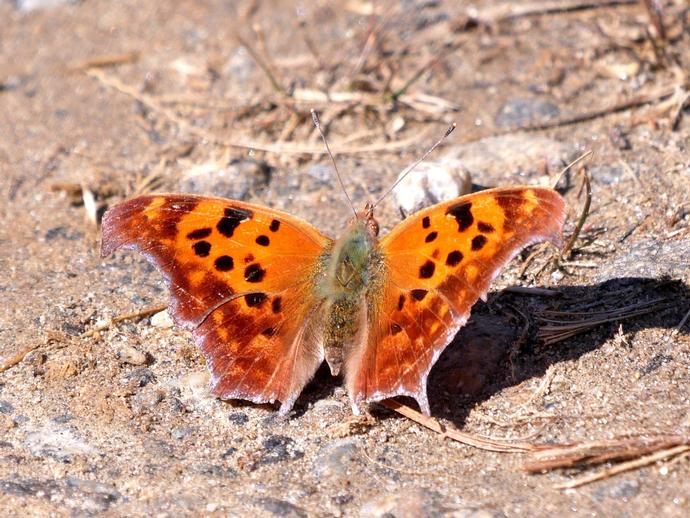March 9, 2021
Ben here with another edition of #BenInNature presented by our friends at Carter Bank & Trust!
Here's a cool find that I spotted just yesterday: Polygonia interrogationis, better known as the question mark!
While there are plenty of insects that remain active throughout the winter and very early spring (most of them small and wildly unphotogenic), I didn't expect to see a butterfly on the wing on March 8! After all, the only flowers in bloom at my place right now are some daffodils and crocuses. However, the question mark is an unusual little butterfly that doesn't play by anyone's rules!
Many butterflies overwinter as eggs or larvae, but the question mark overwinters as an adult! It finds a nice sheltered spot and enters a state of hibernation until the weather warms up. It's easy for it to blend in, because with its wings closed (as you can see in the second photo) it can easily camouflage itself as a dead leaf.
Of course, like me, you probably find yourself wondering what the question mark eats once the weather warms up since very few flowers are in bloom in early spring. As it happens, the question mark isn't big on drinking nectar. Instead, it prefers to get its nutrients from rotting fruit, tree sap, carrion, and even dung! It only visits flowers when those food sources are unavailable (and I assume it does so grudgingly).
The question mark has a wide range and can be found across the eastern portion of the U.S. from the coast to the eastern edge of the Rockies, southern Canada, and Mexico. The larvae feed on a variety of plants, including elm, hackberry, and nettles. You can find the overwintering adults flying from early spring until the end of May. The summer adults take wing from May-September and lay the eggs that become the overwintering adults, which first appear in late August.
By the way, these butterflies get their unusual name from a tiny marking on the underside of the wing that resembles a question mark (unfortunately, it's not visible in these photos). A related and very similar-looking species is Polygonia comma, the comma butterfly, which has a mark on the underside of its wings resembling -- you guessed it -- a comma!
ABOUT #BenInNature
Social distancing can be difficult, but it presents a great opportunity to become reacquainted with nature. In this series of posts, Administrator of Science Ben Williams ventures outdoors to record a snapshot of the unique sights that can be found in the natural world. New updates are posted Monday - Friday, with previous posts highlighted on the weekends. This series of posts is made possible thanks to the support of VMNH Corporate Partner Carter Bank & Trust (www.cbtcares.com)
NATURE PHOTO IDENTIFICATIONS
If you discover something in nature that you would like help identifying, be sure to message us right here on Facebook with a picture (please include location and date of picture) and we'll have our experts help you identify it!

 Hours & Admissions
Hours & Admissions Directions
Directions

